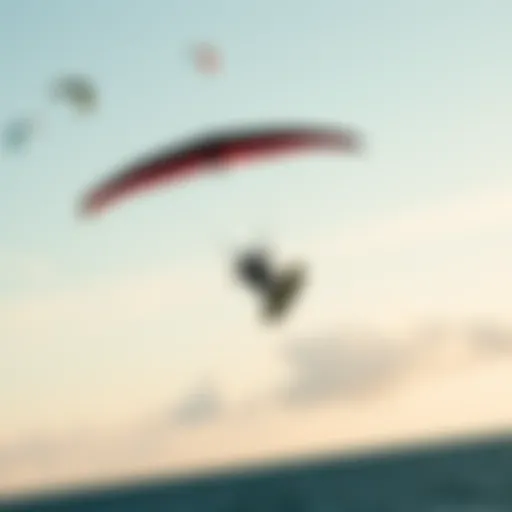Your Complete Guide to Kitesurfing Lessons in LA
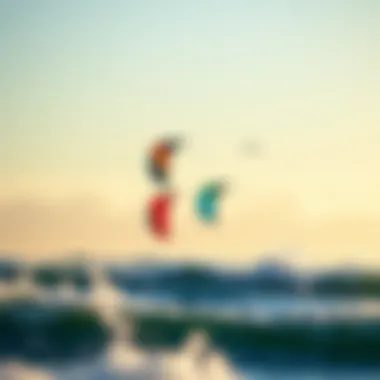
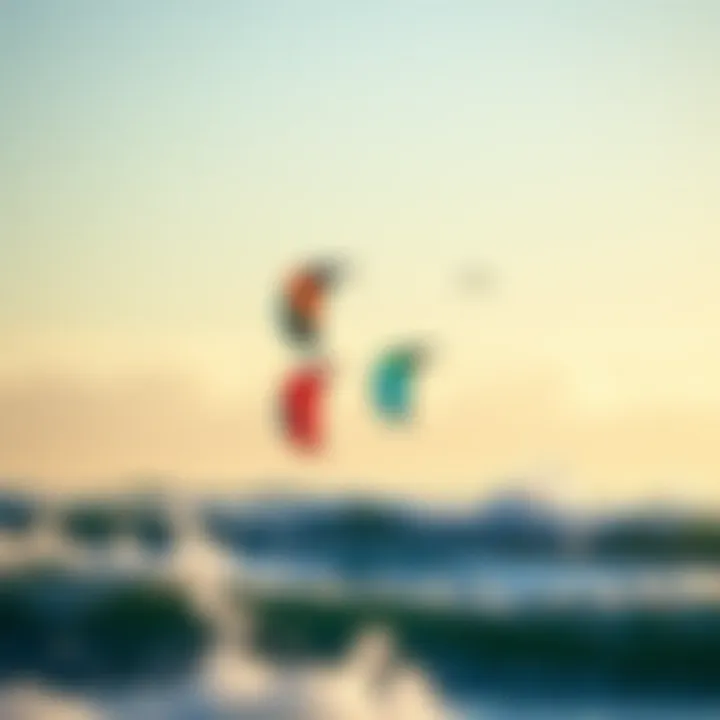
Intro
Kitesurfing is not just a sport; it’s an exhilarating experience that melds the vastness of water, the thrill of wind, and a sense of adventure that few activities can match. If you’re on the cusp of diving into this world in Los Angeles, you've got a fantastic journey ahead. This coastal city, with its stunning beaches and reliable winds, serves as an ideal training ground for both novices and seasoned flyers.
Before you grab a kite and head to the shore, it’s crucial to understand what this sport entails and how to kick-start your learning process effectively. This guide will break down essential aspects of kitesurfing lessons available in Los Angeles, including what gear you'll need, techniques for safely mastering the waves, and how to choose instructors that fit your skill level and learning style.
Diving into kitesurfing can feel overwhelming, but with the right information at hand, you can easily navigate the waters. Knowing what to expect, the resources available, and how to stay safe will turn those waves into a playground of excitement.
Equipment Insights
Kitesurfing is a gear-intensive sport. Understanding the equipment is the first step in ensuring a smoother learning experience. Here's what you need to know.
Latest Gear Reviews
When it comes to kitesurfing, the right equipment can make a world of difference. Recent advancements in gear technology have led to numerous options for both kites and boards. Lightweight materials and improved designs enhance performance and ease of use. Some popular brands you might want to check out include North Kiteboarding and Duotone.
Additionally, focusing on purchasing a kite suitable for your skill level is a must. Beginners typically benefit from larger kites, which provide better stability and ease during learning phases. A common recommendation is the Duotone Neo, praised for its simple handling and great lift, making those initial rides feel less daunting.
"Choosing the right kite is like finding a comfortable pair of shoes; it should feel just right to step into this adventure."
Essential Gear Maintenance
Taking care of your kitesurfing gear is not just a matter of keeping it looking nice; it's about ensuring safety and longevity. Here are some essential maintenance tips:
- Drone Regular Inspections: Check for any tears or damage on the kite fabric. A small hole can lead to bigger issues while riding.
- Wash After Use: Salt and sand can wear down the material. Rinse your gear with fresh water after each session.
- Store Properly: Keep your kites in a cool, dry area. Avoid direct sunlight, which can degrade the fabric over time.
Being proactive about maintenance will save you money down the line, as well as ensure that your gear performs at its best when you hit the water.
Technique Exploration
Understanding techniques is pivotal to your development in kitesurfing. Starting with the basics and gradually working your way to advanced maneuvers can help build confidence and ability.
Beginner Techniques
Beginner techniques often focus on control and balance. As a rookie, it’s imperative to master the following:
- Launching and Landing: Practice launching the kite overhead while ensuring it's windward safe to avoid accidents.
- Body Dragging: This technique helps you get accustomed to the kite's pull in the water without the board initially.
- Water Starts: Once comfortable with body dragging, learning to balance on the board while the kite powers you will be your next goal.
Advanced Maneuvers
Once you have foundational techniques down, it’s time to explore advanced skills that can elevate your kitesurfing experience:
- Jumping: Learning to generate lift with your kite and timing your jumps will take practice but opens up a world of exhilaration.
- Transitions: Switching directions smoothly while maintaining speed can elevate your flair on the water.
- Tricks: Once confident, attempting tricks like the back roll or front roll can add both style and excitement to your kiting experience.
Kitesurfing, while thrilling, demands respect towards the ocean and understanding of safety precautions that should never be taken lightly. In addition to honing techniques, familiarize yourself with conditions and local rules on waterways to ensure a safe and enjoyable experience.
As we move through this guide, keep in mind that the journey of kitesurfing is not just about mastering the sport—it's about enjoying the learning process, the community, and the incredible natural beauty that surrounds you while kiting in Los Angeles.
For more information on kitesurfing and equipment, feel free to explore resources like Wikipedia and forums on Reddit.
Foreword to Kitesurfing in Los Angeles
Kitesurfing has taken a significant hold in coastal cities across the globe, and Los Angeles stands at the forefront of this exhilarating sport. With its endless blue skies and consistent winds, the city is not just a picturesque backdrop but an ideal haven for both novice and seasoned kitesurfers. The essence of this sport lies in the synergy between wind, water, and the rider, and Los Angeles offers a unique environment that fosters this relationship.
Essentially, why should one consider kitesurfing here?
- Diverse Locations: From the trendy beaches of Venice to the wide expanses of Dockweiler State Beach, the variety of spots caters to different skill levels, enabling learners to find the right fit based on their comfort and expertise.
- Strong Community: The kitesurfing community in Los Angeles is welcoming and vibrant. Local clubs and organizations frequently host events, workshops, and competitions, making it easy for newcomers to connect and learn. Engaging in this community not only provides support but also enhances the learning experience.
- Expert Instruction: With numerous schools and instructors offering lessons tailored to every skill level, aspiring kitesurfers have access to quality education. These instructors bring their experience to the table, often incorporating the unique conditions found in Los Angeles beaches in their teaching. It makes the lessons more relatable and applicable.
- Weather Conditions: The climate in Los Angeles is another prime factor. Warm temperatures year-round, combined with predictable wind patterns, create a consistent environment for kitesurfing. This predictability allows beginners to schedule their lessons with confidence, minimizing the risk of unexpected cancellations.
Kitesurfing in Los Angeles is more than just a sport; it represents a lifestyle intertwined with the ocean, adventure, and camaraderie.
Investing time in kitesurfing lessons here means more than just learning to glide over the waves; it symbolizes embracing a thrilling culture that encourages personal growth, athleticism, and an appreciation for one of nature's most powerful elements—the wind. As we delve further into this guide, we will explore the intricacies of kitesurfing, aiming to equip prospective learners with valuable knowledge that will enhance their journey in this exciting sport.
Understanding Kitesurfing
Understanding kitesurfing is fundamental for anyone looking to leap into this thrilling sport. Not only does it encompass the practical skills required to ride the waves, but it also entails appreciating the underlying mechanisms, history, and culture that shape kitesurfing today. When prospective kitesurfers grasp the essentials, they position themselves better to make informed decisions about lessons, equipment, and personal safety.
As you delve into kitesurfing, it becomes clear that the sport is not merely about hanging onto a kite while skimming the surface of the water. It’s a harmonious blend of physicality, awareness of the environment, and knowing your equipment inside and out. Whether you're a beginner eager to dip your toes into the ocean or an advanced rider seeking to polish your skills, understanding the nuances of this sport can significantly enhance your experience.
History of Kitesurfing
Kitesurfing, sometimes called kiteboarding, did not appear overnight. Its roots trace back centuries; the first documented use of kites for propulsion dates to ancient China when kites were employed for military purposes. Fast forward to the late 20th century, and you witness the first attempts to blend surfing with kites.
In the 1990s, pioneers like Bruno Legaignoux and Cesar Tatoo start experimenting with shaping kites for the water. These early versions were often primitive by today’s technological standards but laid the groundwork for what followed. The introduction of inflatable kites brought a significant leap in safety and ease of use, making it more accessible to the masses. By the early 2000s, kitesurfing was recognized globally, with numerous competitions and dedicated communities blossoming aboard beaches and coasts worldwide.
Understanding this history enriches your kitesurfing journey, shedding light on how the sport has evolved to become safer and more enjoyable. It’s fascinating to think about the individuals who pushed the boundaries, enabling today’s riders to thrive in the sport.
The Mechanics of Kitesurfing
The next thing to grapple with is the mechanics of kitesurfing. A kitesurfer’s skill lies not just in mastering tricks but also in understanding how wind, water, and kite interact.
- Kite Dynamics: Every kite operates on principles of lift and drag—these influence how the kite behaves in different wind conditions. Understanding how to control your kite in various settings—light winds, strong winds, or gusty conditions—is crucial.
- Body Positioning: How you position your body on the board affects your stability and control. Leaning back can help against strong winds, while positioning forward may provide speed.
- Wind Awareness: Knowing how to read wind patterns can prove a game-changer on the water. Keeping an eye on the water’s surface helps interpret wind direction and intensity.
As you gain experience, the mechanics of kitesurfing will become second nature. This knowledge not only makes you a more skilled rider, but it also cultivates a deeper respect for the sport. With the right understanding, riding those waves becomes not just a pastime but a fulfilling experience, where you connect with nature like few others.
“Kitesurfing requires more than just muscle; it demands a blend of intuition and intellect.”
Tuning into the essence of both the sport and the environment creates an enriching journey for kitesurfers. In essence, from its storied past to its intricate mechanics, understanding kitesurfing is the first step toward your adventure. Whether you’re chasing the thrill of an adrenaline rush or seeking tranquility on the water, knowing your stuff will guide you to make smart choices on your way.
For more information on the evolution of kitesurfing, you can refer to resources like Britannica or delve into discussions at Reddit to engage with the community.
Why Choose Los Angeles for Kitesurfing Lessons
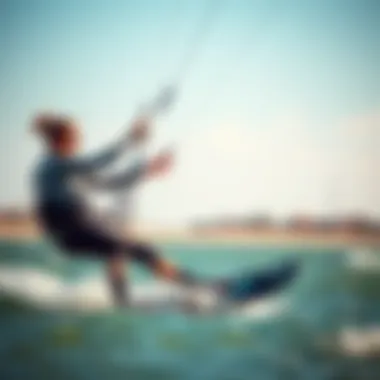
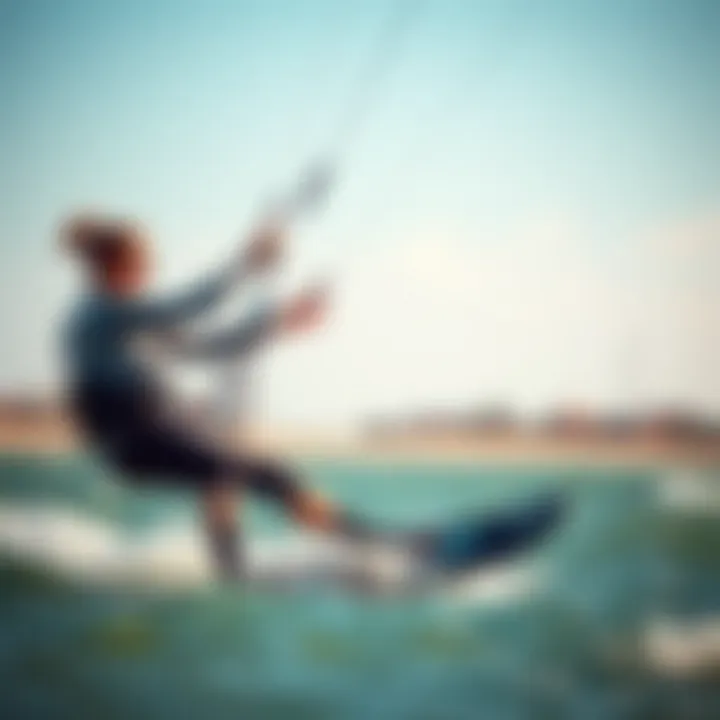
Los Angeles is a standout location for kitesurfing lessons, offering a unique combination of geographical advantages, climate considerations, and a vibrant kitesurfing community. These elements make LA not just a destination but a prime locale for both novice and seasoned riders looking to hone their skills. Learning this thrilling sport in such an iconic setting combines adventure with a breathtaking backdrop, setting the stage for a rewarding experience.
Geographical Advantages
One of the key draws of Los Angeles for kitesurfing is its diverse geography. The city sprawls along the coastline, showcasing a variety of beaches, each with its own characteristics suitable for kitesurfing.
- Varied Beach Options: Locations like Santa Monica and Venice are known for their relatively consistent winds and gentle terrain, ideal for beginners. On the other hand, spots like Sunset Beach or El Porto cater to more advanced riders seeking a challenge with stronger winds and waves.
- Wind Patterns: The often prevailing winds that sweep through the region create perfect conditions for kitesurfing. The Santa Ana winds, for instance, can offer thrilling gusts, making any lesson an adventure rather than just a routine training session.
- Accessibility: With the city’s extensive infrastructure, reaching these beaches is usually straightforward. Public transport, along with a myriad of parking options, facilitates easy access, allowing aspiring kitesurfers to focus more on their lessons and less on logistics.
These geographical aspects heighten the learning experience, enabling riders to practice in varied conditions, preparing them better for when they tackle different waters.
Climate Considerations
The climate in Los Angeles is another noteworthy aspect that makes it a prime signing up destination for kitesurfing. With its Mediterranean climate, LA boasts plenty of sunny days, usually complemented by mild temperatures, which ensures a pleasant experience for anyone venturing out on their board.
- Year-round Opportunities: With over 300 days of sunshine annually, kitesurfing can be enjoyed nearly any day of the year. This accessibility means students are not confined to waiting for a specific season, giving them the freedom to pursue lessons when it best suits their schedules.
- Consistent Wind Seasons: While the summer months may bring lighter winds, the fall often provides robust and dependable breezes, perfect for those looking to refine their skills. Understanding how weather patterns work year-round helps students in planning their learning strategy.
- Mild Water Conditions: The ocean conditions in LA are generally forgiving. Warmer water temperatures increase comfort levels for beginners who might be apprehensive about the cold, while avoiding more extreme weather conditions that can take away from the learning experience.
In summary, the geographical and climatic aspects of Los Angeles create an ideal platform for kitesurfing lessons. The opportunities to learn in a stunning locale, combined with favorable weather and accessible beaches, makes LA an unforgettable place to take to the waves.
Types of Kitesurfing Lessons
When venturing into the world of kitesurfing, understanding the types of lessons available is crucial. The choices you make can significantly influence your learning experience and how quickly you progress. Whether you're just starting out or looking to hone your skills, knowing the various instructional options can tailor your experience to meet your specific needs. Lessons in kitesurfing are typically designed to cater to different skill levels and preferences, which plays a vital role in fostering a safe and enjoyable environment for all aspirants.
Beginner Level Courses
For those stepping onto the water for the first time, beginner courses are foundational. These lessons often serve to instill confidence in newcomers while introducing them to the essentials of kitesurfing. Content of such courses usually includes:
- Understanding Equipment: Participants learn about the kite, the harness, the board, and the safety gear — knowing your tools before hitting the waves is half the battle.
- Basic Control Techniques: Newcomers practice controlling the kite on land before getting in the water. Learning to launch and land the kite without hassle is vital.
- Water Safety: Emphasis is placed on safety measures in the water, including recognizing different water conditions and signals for help.
Instructors know that foundational skills are key, and they often tailor lessons to accommodate personal learning speeds. Students can expect a mix of practical training and theoretical knowledge that lays a strong base for their future kitesurfing journey.
Intermediate and Advanced Training
Once a kitesurfer progresses beyond the basics, intermediate and advanced training occur. These lessons are tailored for individuals looking to refine their skills and tackle more complex maneuvers. Training typically involves:
- Advanced Techniques: Courses may cover jumping, trick execution, or navigating challenging water conditions. Enhancing board skills while mastering kite control under varied conditions is essential in this phase.
- Skill Assessment: Instructors often provide feedback, allowing students to identify areas that need improvement. They may work on specific tricks or refine techniques already learned.
- Personalized Goals: Individuals can set personal challenges that instructors help guide them through.
These sessions often become a platform for riders to express themselves creatively on the water while honing their athleticism.
Private vs Group Lessons
Choosing between private and group lessons can greatly influence your learning experience in kitesurfing. Each option comes with its own set of advantages based on personal preference and learning style:
- Private Lessons: These offer tailored instruction, focusing specifically on the student's needs and pace. The personal attention can speed up the learning curve significantly. It's a way to work closely with an instructor, ensuring immediate feedback and strategies that cater precisely to how one learns.
- Group Lessons: This format allows for a more social approach. Students can learn from each others' experiences, share tips, and even challenge themselves in friendly competition. Group lessons tend to be lighter on the wallet, and the camaraderie built amongst participants is often a highlight.
Both formats have their merits. A private lesson can provide more effective learning for someone needing straightened focus, while a group lesson can make the experience more enjoyable.
"Choosing the right lesson format can be a game-changer in your kitesurfing journey. Understand your goals and pick what suits you best!"
In summary, the types of kitesurfing lessons play a crucial role in shaping the experiences of new enthusiasts and seasoned riders alike. Understanding the various levels and styles of lessons can significantly enhance one's kitesurfing journey.
Finding the Right Kitesurfing Instructor
Choosing the right kitesurfing instructor can make or break your experience on the water. An effective instructor not only teaches you the skills needed to ride safely but also instills confidence and enthusiasm, allowing you to grow in the sport. This section dives into the elements that are vital for finding the perfect instructor tailored to your unique needs, ensuring a positive and enriching learning experience.
Certification and Experience
When it comes to kitesurfing, a solid foundation rests on having an instructor who possesses the appropriate certifications and experience. Look for instructors who have completed recognized programs, such as those accredited by the International Kiteboarding Organization (IKO) or the Professional Air Sports Association (PASA). These certifications testify to an instructor's knowledge about safety protocols, teaching methodology, and the necessary technical skills involved in kitesurfing.
It’s important to also consider the years of experience an instructor brings to the table. A veteran instructor, who has faced various weather conditions and challenges, is often better equipped to provide practical solutions and advice when things don’t go as planned.
Furthermore, some instructors have specialized training that can be beneficial to particular groups such as beginners, youth, or those with disabilities. Checking their track record with previous students, and seeking out testimonials can provide valuable insights.
Remember: An experienced instructor can make learning faster and more enjoyable, guiding you safely through the early stages of the sport.
Teaching Style Considerations
No two instructors teach in exactly the same manner, and understanding their teaching style is crucial. It’s somewhat like fitting a round peg into a square hole; if the teaching method doesn’t resonate with your learning preferences, it could hinder your progress.
Some instructors adopt a hands-on approach, getting into the water with you to demonstrate techniques. Others may prefer giving detailed explanations while you observe from the beach. Reflect on how you learn best: do you need more direct involvement to grasp concepts, or do you prefer to observe first?
Additionally, consider the emotional atmosphere created by the instructor. An encouraging, patient instructor can make a world of difference, especially for beginners. This nurturing environment fosters a sense of safety, allowing you to take risks without the fear of failure weighing heavy on your shoulders.
As you explore potential instructors, don't hesitate to ask about trial lessons or private sessions. Engaging in a conversation about their philosophy on teaching can also reveal a lot about how they connect with their students. Having discussions about your goals and expectations can pave the way for a more tailored learning experience.
Your instructor should be someone who not only teaches skills but becomes a mentor, guiding you to discover the waves with confidence.
Essential Safety Measures
Kitesurfing is not just about the exhilarating rush of gliding over the waves; it inherently involves certain risks, just like any sport that dances with nature’s elements. Thus, understanding and implementing essential safety measures is not merely a recommendation but a must for anyone looking to enjoy this activity in Los Angeles. Below, we delve into two crucial aspects of safety that every prospective kitesurfer should grasp.
Pre-Lesson Safety Briefings
Before you even dip your toes into the water, attending a comprehensive safety briefing is vital. These sessions, often held by your instructor, cover fundamental safety protocols and equip you with the knowledge to handle unexpected situations. Here’s what you can commonly expect:
- Kite Control: Understanding how to control your kite and prevent potential accidents like tangling or crashing will be central in these briefings.
- Emergency Situations: Instructors will explain what to do if things go sideways, such as dealing with strong winds or equipment failures.
- Identifying Hazards: Local conditions at different beaches can vary greatly. Knowing about potential hazards like rocky outcrops, busy waterways, or even wildlife can save you from an unpleasant experience.
Making sure you are well-versed in these preliminary safety measures is not just prudent; it can make a world of difference for your safety and enjoyment.
"Before you hit the water, it’s crucial to arm yourself with knowledge. Safety briefings are your first line of defense against mishaps that can put a damper on your kitesurfing adventure."
Documenting Weather Conditions
Weather can be a fickle friend or foe when it comes to kitesurfing. Thus, knowing how to document weather conditions before hitting the waves is equally essential. Here’s why keeping an eye on the weather is paramount:
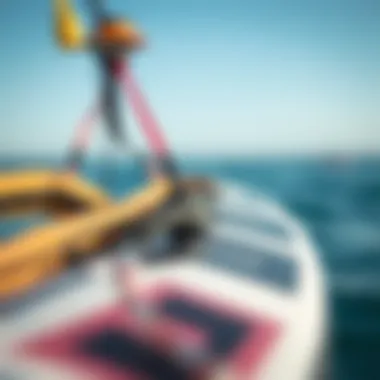
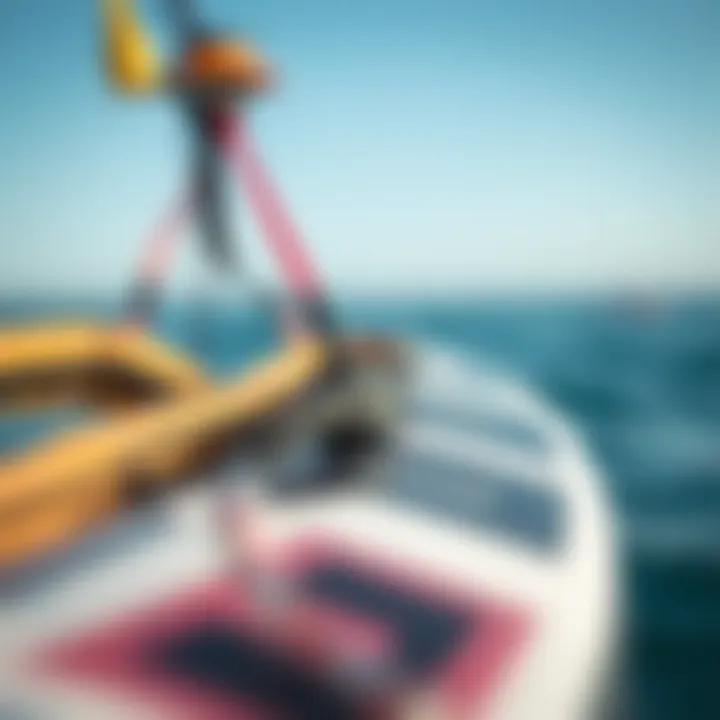
- Wind Speed and Direction: Various kites perform differently based on wind conditions. It’s vital to understand what conditions your chosen kite handles best, and adjust your plans accordingly.
- Water Conditions: Understanding the state of the water, including waves and currents, helps assess if it’s safe to go kitesurfing. Conditions can change rapidly, making real-time monitoring an absolute must.
- Forecasts and Alerts: Utilize resources like local weather stations or apps designed for watersports enthusiasts. Keeping tabs on alerts can help you steer clear of storms or strong winds that could compromise your safety.
This nuanced understanding of weather conditions can significantly enhance not only your kitesurfing performance but also your safety.
In summary, embracing these essential safety measures prepares you for a kitesurfing experience that is not only thrilling but also secure. With knowledge of pre-lesson briefings and weather documentation, you set the stage for an enjoyable, memorable time on the water.
Kitesurfing Equipment Overview
Kitesurfing equipment is more than just a collection of gear; it embodies the very essence of the sport. Having the right tools at your disposal significantly affects not only your experience but also your safety and progression in learning. In the bustling kitesurfing scene of Los Angeles, where the winds can be tricky and where learners are eager to ride the waves, understanding the intricacies of your kitesurfing setup is paramount.
When you're gearing up to master this exhilarating sport, you'll find that each piece of equipment plays its part in enhancing performance and optimizing enjoyment. The three main components you’ll commonly hear about are the kite, harness, and board, each serving distinct purposes tailored to various skill levels.
Before diving into the specifics, it’s essential to note that familiarity with your equipment can build confidence. Whether you’re a greenhorn or a seasoned rider, understanding your kitesurfing gear creates a safety net and allows you to evaluate your progress and skills effectively.
Kite Selection Based on Skill Level
Choosing the right kite is perhaps the most critical decision to make when entering kitesurfing. Kites vary in size, shape, and type, and each of these attributes plays a specific role in determining how well you will perform on the water.
- Beginners often benefit from a larger kite, generally in the range of 10 to 12 square meters. These kites provide more power and lift, making it easier to learn fundamental techniques. However, too much power can also lead to challenges, especially when wind conditions become unpredictable.
- As one gains experience, transitioning to a smaller kite, around 7 to 9 square meters, enables riders to harness their advanced skills. A smaller kite is generally more manageable, allowing for sharper maneuvers and enabling riders to experience higher speeds with control.
When selecting a kite, consider the conditions you will be kiting in:
- Wind Strength: Strong winds require smaller kites, while light winds favor larger kites.
- Riding Style: Freestyle riders might prefer kites that offer a quick response and less pull, while wave riders might choose kites with greater stability.
Selecting a kite based on your skill level not only enhances performance but dramatically increases safety.
Harness Types and Their Uses
The harness is your connection to the kite and is crucial for controlling power. It allows you to distribute the force of the kite across your body, preventing fatigue during long rides. There are primarily two types of harnesses:
- Seat Harnesses: These are typically recommended for beginners. They sit lower on the body and provide extra support, offering a secure fit that helps mitigate the risk of slipping out. These harnesses are beneficial for those who may struggle with balance.
- Waist Harnesses: As one progresses, a waist harness's lighter weight and increased freedom of movement can be appealing. They provide a snug fit around the waist, enabling a more unrestricted range of motion. However, they require better core strength and control, which may not be ideal for novices.
When choosing a harness, it’s vital to consider the fit and comfort, as well as your riding discipline. A well-fitting harness will reduce the risk of discomfort and injury, allowing for longer, more enjoyable sessions.
Board Options and Their Characteristics
Boards are as varied as kites but play an equally vital role in your kitesurfing journey. The type of board you select will depend on multiple factors, including skill level, local conditions, and personal preferences.
- Twin-Tip Boards: These are the most common and beginner-friendly. They can be ridden either way, making learning easier. They also provide stability and good buoyancy, allowing for smooth rides.
- Directional Boards: Often favored by advanced kitesurfers, these boards are intended for wave riding. They require more skill and commitment as they’re designed to be ridden in one direction only.
- Foil Boards: Gaining traction in the kitesurfing community, foil boards let you glide above the water’s surface. These are suitable for more experienced surfers looking for an alternative kiting experience.
Considerations when selecting a board:
- Size: Larger boards provide more stability, while smaller boards allow for quicker turns and tricks.
- Material: The construction of the board affects its flexibility and durability, impacting performance.
- Weight: A lighter board can be easier to maneuver but may require more skill to maintain control.
Every piece of equipment matters in kitesurfing, and understanding each component can lead to a more fulfilling learning experience and greater enjoyment on the water.
Remember, safety first; always inspect your equipment before hitting the waves!
Techniques and Skills Covered in Lessons
Kitesurfing isn’t just about flying a kite or riding a board; it’s about merging both elements smoothly to create an exhilarating experience on the water. When you sign up for kitesurfing lessons, you essentially enroll in a progressive journey. This journey involves understanding vital skills and techniques that can make the difference between a thrilling ride and a frustrating wipeout. Grasping these fundamentals is essential for both beginners and seasoned flyers hoping to harness the wind more proficiently.
Different skills will be taught to match your level, making it easy to identify exactly what you need to learn based on your experience. You'll not only pick up the ropes in terms of kitesurfing but also get a grip on elements such as wind dynamics, body posture, and water navigation techniques, which together lend to a fulfilling kitesurfing experience.
Basic Maneuvers
Before diving into the advanced tricks that make Kitesurfing so enticing, mastering basic maneuvers is crucial. Things like recognizing wind direction, learning how to control the kite, and executing fundamental transitions set the groundwork for everything that comes next:
- Launching and Landing: Learning how to properly launch and land your kite ensures your safety and the safety of those around you. Keeping the kite steady while getting in or out of the water takes practice but pays off handsomely.
- Riding Upwind: This maneuver involves angling your board and kite in relation to the wind, allowing you to ride against it effectively. It takes some time to nail, but it is necessary to maintain your position on the water.
- Turning Techniques: Knowing how to turn using your body weight and kite control allows you to change direction smoothly. Mastering the art of turns ensures a more fluid and enjoyable ride rather than sporadic jerks and stops.
Underneath these basic skills lies a connectect thread of body awareness and understanding its relation to the kite. Once you feel comfortable with these movements, the experience will begin to feel second nature.
Advanced Tricks for Experienced Riders
For those who have grasped the fundamental maneuvers and feel comfortable zipping across the waves, it's time to take things up a notch. Advanced tricks not only provide a rush of adrenaline but also enhance your control and agility when you're kitesurfing:
- Jumping: It’s one of the hallmark moves of kitesurfing. Jumping requires a careful mix of timing and technique; it starts with the correct kite angle to create lift, a strong pull from the board during takeoff, and finesse during the descent for a smooth landing.
- Backrolls and Frontrolls: These tricks involve flipping in the air and can dramatically elevate your kitesurfing repertoire. They require precise timing and understanding of body rotation, ensuring you understand kitesurfing mechanics well.
- Handle Passes: For the more adrenaline-seeking soul, handling the bar while airborne takes skill and practice. This involves passing the kite’s control bar from one hand to the other mid-air, thereby allowing for a dynamic switch during the jump.
To sum it up, moving from basic maneuvers to advanced tricks is not just about learning new moves; it’s about expanding your connection with the elements, enhancing your speed, and ultimately finding your unique style on the water. Whether you’re in a lesson or practicing solo, knowing what to aim for can turn a good session into a great one.
"Kitesurfing is not just about conquering the waves; it’s about mastering yourself in the wind."
Fruits of practice can go a long way, and all rides—successful or otherwise—teach valuable lessons, which only add to one’s experience and enjoyment of the sport. Embracing a progressive learning curve with patience ensures that your kitesurfing adventure is as rewarding as it can be.
Post-Lesson Progress Tracking
Tracking progress after your kitesurfing lessons is the keystone in improving your skills and enhancing your overall riding experience. Many people might think that once the lesson is over, the learning stops. However, consistent evaluation and goal-setting are what separates average riders from exceptional ones. Making note of what you accomplished, what needs polishing, and setting your sights on future skills to master can significantly enhance your progress.
Setting Personal Goals
When you set personal goals, you’re essentially mapping out your journey as a kitesurfer. These goals should be SMART – Specific, Measurable, Achievable, Relevant, and Time-bound. For instance, instead of vaguely stating, "I want to get better at kitesurfing,” aim for more definitive targets like, "I want to successfully complete a transition by the end of my next three lessons.”
As the old saying goes, "Aim for the moon. If you miss, you might hit a star.” These specific goals provide you something to work towards, enabling you to focus your lessons and practice sessions effectively. Regularly reviewing these goals allows you to adjust them as you progress. You can stay on your toes and make sure you’re challenging yourself without stepping too far into the deep end.
Regular Skills Assessment
Regular skills assessment ensures that you’re not just learning but also applying what you’ve picked up. Following each lesson, reflect on what you’ve practiced. Consider questions like:
- Which maneuvers feel comfortable?
- What still seems challenging?
- Are there particular techniques that require more practice?
Maintain a simple journal or a digital log, documenting each session’s focus. For example, if you practiced controlled landings, jot it down, noting any successes and areas still needing work. This practice not only reinforces your learning but also gives your instructor insights into your growth, enabling them to tailor future lessons to better fit your needs.
Moreover, frequent assessments serve as motivational check-ins. They can light a fire under you when you see tangible progress and indicate when it’s time to step up the game.


"The journey of a thousand miles begins with one step.”
- Lao Tzu
In summation, post-lesson tracking—through personal goals and regular skills assessments—is crucial. It allows you to maintain a positive growth trajectory and keeps your momentum alive as you continue to learn and refine your craft. Diving into kitesurfing is a thrilling and rewarding adventure; ensuring you regularly evaluate your progress will help make that ride as smooth as possible.
Kitesurfing Community and Culture in Los Angeles
Kitesurfing in Los Angeles is more than just a sport; it embodies a rich culture and community that resonates through the beaches and waters of this vibrant city. Kitesurfers here share a unique connection, blending thrills of the waves with the camaraderie that comes from sharing adventures. The strong sense of community plays an essential role in welcoming both new and experienced kiteboarders alike, fostering an environment where learning, sharing, and improving skills becomes a collective cause.
The culture surrounding kitesurfing in L.A. thrives on the idea of inclusion. Whether you are cruising along the shores of Venice Beach or hitting the waves in Santa Monica, there’s an undeniable unity among riders that creates a lively atmosphere. Local knowledge and tips are often passed down from one kiter to another, helping novices get up and running quickly while allowing seasoned pros to refine their skills. This environment not only helps in skill development but also opens doors to friendships that often last a lifetime.
Among the buzz of the kitsurfing community, a variety of loal events and competitions bolster the culture, enlivening the kitesurfing scene throughout the year. These gatherings are a mix of fun, friendly rivalry, and social engagement, amplifying the sense of belonging.
"The soul of kitesurfing in Los Angeles lies in its community. Every session becomes a celebration of sport and friendship."
Local Events and Competitions
Los Angeles hosts a range of kitesurfing events and competitions that cater to every level of expertise. Local kite schools and clubs often organize these events, allowing kitesurfers to showcase their skills and learn from others. Competitions can vary from freestyle battles to race series, targeting both amateurs and professionals.
- Venice Kitesurfing Festival: This annual event brings together enthusiasts from all corners of the city, celebrating the spirit of kitesurfing through workshops, competitions, and beach parties. Participants can join in, whether as competitors or spectators, soaking up the electric atmosphere.
- Kiteboarding League Competitions: These events are organized by local clubs and provide an excellent platform for riders to compete and improve their skills. They often include different categories from beginner to advanced, making it accessible for everyone.
- Social Gatherings and Meet-ups: Beyond competitions, the community thrives on informal gatherings where kiters can share tips, experiences, and even gear. Many local shops help facilitate these gatherings, promoting a sense of togetherness.
Social Media and Online Resources
In this digital age, the kitesurfing community in Los Angeles has effectively utilized social media and online platforms to foster connection. Social media groups on platforms like Facebook and Reddit are full of active members sharing videos, tips, and event notifications, making it an invaluable resource.
- Facebook Groups: Numerous groups specifically geared toward Los Angeles kitesurfers provide a platform for discussion, collaboration, and sharing experiences. Here, members can ask questions about gear, get advice on local spots, and even arrange meeting up for sessions.
- Instagram: Many local riders showcase their skills on Instagram, providing visual inspiration and attracting more people to the sport. It's a great way to stay updated on skills being practiced, and many instructors share useful tips through their accounts.
- Online Forums: Websites like Reddit host several discussions about kitesurfing techniques, places to practice, and gear reviews. These forums can be a treasure trove of information for both beginners and seasoned riders looking to refine their craft.
- YouTube Channels: There are tons of instructional videos available from local instructors and experienced riders. This not only aids in understanding different techniques but also helps in visualizing the gear in action.
Utilizing these platforms fosters a greater sense of connection among kiteboarders, helping everyone engage and grow within the community. The supportive atmosphere and shared knowledge make learning and enjoying kitesurfing even more enriching in Los Angeles.
Environmental Considerations in Kitesurfing
Kitesurfing, while undoubtedly exhilarating, poses certain environmental concerns that every rider should be acutely aware of. As an ever-growing sport, kitesurfing can inadvertently impact coastal ecosystems, especially in locales renowned for their beaches, like Los Angeles. This section dives into the essential environmental considerations, highlighting sustainable practices that not only protect our water and land but also enhance the kitesurfing experience.
Sustainable Practices
Engaging in sustainable practices is imperative for the longevity of kitesurfing as both a sport and a recreational activity. Here are a few practices that kitesurfers should adopt:
- Respecting Local Guidelines: Many locations have specific guidelines to follow. These can range from designated kitesurfing zones to rules about equipment usage. Heeding these regulations ensures that natural habitats remain undisturbed.
- Using Eco-Friendly Gear: Opt for kites and boards made from environmentally conscious materials. Several brands are now getting ahead of the curve, producing equipment that minimizes negative effects on marine environments.
- Avoiding Plastic: It's high time to shun single-use plastics. Whether it’s water bottles, snack wrappers, or equipment packaging, opting for reusable or biodegradable options helps keep our shores pristine.
"Taking care of the beaches and waters where we kite is not just a duty, it's a privilege. Let's be stewards of the earth, not just riders of the waves."
These small but significant actions can collectively help protect the beaches that provide us joy and adventure, ultimately benefiting all water users.
Conservation of Local Marine Life
Kitesurfing often takes place in delicate marine environments bustling with life. Understanding how our actions might disrupt these ecosystems is essential for fostering harmony between our sport and nature. Here are vital points to consider:
- Awareness of Wildlife: Beaching, launching, and landing kites can disturb local wildlife, including nesting birds and marine creatures. Kitesurfers should always keep a lookout for signs indicating sensitive areas and strive to avoid those altogether.
- Protecting Marine Flora and Fauna: The ocean’s ecosystem is fragile. Riders should avoid areas with known seagrass beds and coral reefs, as the scouring of equipment can lead to significant damage.
- Be Mindful of Disturbances: Be aware of noise created from equipment and human activity. Loud noises can scare off wildlife, particularly sensitive species. Keeping noise levels down is as important as physical footprints when it comes to preserving nature.
In summary, maintaining an awareness of our environmental impact while kitesurfing in Los Angeles is not just responsible; it enhances our connection to the sport itself. When we take steps to protect our local environment, we ensure that kitesurfing remains a viable, enjoyable pastime for generations to come.
Investment and Budgeting for Lessons
When embarking on the journey of kitesurfing, one of the first considerations that comes to mind is investment and budgeting for lessons. This aspect is pivotal, as it directly influences one's learning experience, access to quality instruction, and ultimately, satisfaction with the sport. Let's break down the factors involved to give potential kiteboarders a solid handle on costs while ensuring they make informed choices.
Offering a solid foundation for newcomers, budgeting effectively for lessons can also make a significant difference in how well someone progresses. Kitesurfing is not just a sport but a lifestyle, and investing wisely in quality instruction and equipment can set the stage for years of enjoyment.
Cost Analysis of Lessons
When it comes to the financial angle of kitesurfing lessons, several variables come into play. Typically, lessons can range anywhere from $100 to $300 per session, depending on the instructor's experience level, class size, and location within Los Angeles. Here are some key points to consider:
- Private vs. Group Lessons: One-on-one instruction tends to be pricier but allows for personalized attention, while group lessons may be more cost-effective but offer less individualized support.
- Duration of Lessons: Longer sessions often come at a premium, but they can also provide an opportunity for deeper learning and practice. A two-hour lesson might cost slightly more than a one-hour lesson, but the additional time is frequently beneficial for skill acquisition.
- Instructor Credentials: Experienced instructors with certifications will generally charge more, reflecting the value of their knowledge and expertise. This could be a worthy investment for those serious about mastering kitesurfing.
Additionally, when assessing costs, it’s wise to account for supplemental expenses such as travel to the beach, rental fees for gear (if not owned), and requisite safety equipment. One good rule of thumb is to allocate approximately 20% more than the base lesson fee to cover these extra expenses.
Long-term Gear Investments
In addition to the initial investment in lessons, it's essential to consider long-term gear investments. Owning your own equipment can significantly enhance the kitesurfing experience, making it more enjoyable and convenient. Here's what to keep in mind:
- Kite and Board Quality: Investing in a high-quality kite and board is crucial. While beginner gear may seem like a cost-saving measure, subpar equipment can hinder learning and be less forgiving during mishaps. Brands like Naish, Cabrinha, and Slingshot are often favored for their durability and performance.
- Safety Gear: Don't skimp on safety equipment. A reliable harness, helmet, and impact vest are non-negotiable when enjoying the sport. They may seem like additional costs upfront, but they are wise investments for safety.
- Maintenance and Upkeep: Equipment requires care. Setting aside funds for maintenance, such as repairs or replacements (particularly for kites that can wear out over time), should also be factored into the budget. A regularly maintained kite lasts longer, translating into a better experience for the rider.
As you refine your budgeting skills and invest thoughtfully in lessons and gear, you're not just spending money; you're laying down the groundwork for a rewarding kitesurfing journey. Careful planning can mean all the difference between a fleeting interest in the sport and a lifelong passion.
"A penny saved is a penny earned" – making wise financial choices today lays the path for endless waves tomorrow.
For more insights into budgeting and costs involved in kitesurfing, check this informative Reddit discussion or visit global kiteboarding resources.
By taking the time to analyze costs and plan for gear investments, aspiring kitesurfers can steer clear of overspending while maximizing their experience on the water.
Culmination and Next Steps
As we reach the end of this extensive exploration into kitesurfing lessons in Los Angeles, it becomes clear that concluding thoughts and future steps are vital. This section serves as a bridge, connecting your newfound knowledge with the exhilarating pursuit that lies ahead in your kitesurfing journey.
Understanding the ins and outs of kitesurfing is just the beginning. It’s not merely about mastering the techniques or having the latest gear. It’s about arming yourself with information and skills essential for safe and enjoyable experiences on the water. Recall that each lesson brings something crucial beyond just practical skills – it’s about building confidence and fostering community.
Recap of Key Points
Throughout this guide, we covered several critical aspects of kitesurfing lessons:
- Wide Array of Learning Options: From beginner courses to advanced techniques, there’s a style of teaching for every skill level.
- Finding the Right Instructor: The importance of selecting an instructor who is both certified and aligns with your preferred learning style cannot be emphasized enough. Choose wisely, as this key factor can dramatically impact your learning curve.
- Safety First: Familiarizing yourself with safety measures isn’t just recommended; it’s a necessity. Pre-lesson briefings and constant awareness of weather conditions help ensure that you’re not just kitesurfing but doing so responsibly.
- Community Engagement: The kitesurfing community in Los Angeles is vibrant and welcoming. Getting involved can enhance your experience; learning from others and sharing your progress creates bonds that last beyond the waves.
Encouragement for Continued Learning
Kitesurfing is not a one-and-done affair; it’s a journey of ongoing learning and adaptation. No matter your current skill set, remain open to refining your abilities and absorbing new insights. Consider chasing certifications or attending kitesurfing workshops, as these can be excellent avenues for growth. Before you know it, you’ll find yourself trying out advanced tricks or simply enjoying the elements with greater proficiency.
Engaging with online forums like Reddit or social media groups enables you to stay updated with the latest in the kitesurfing world. Sharing experiences, seeking advice, and learning about regional kitesurfing conditions can only enhance your skills and passion.
Kitesurfing is more than a sport; it’s an adventure that intertwines with nature and community. Keep pushing your limits and soaking in every lesson, and watch your skills flourish like a kite floating gracefully against the ocean breeze. The horizon is calling, and the next wave is just waiting for you.

